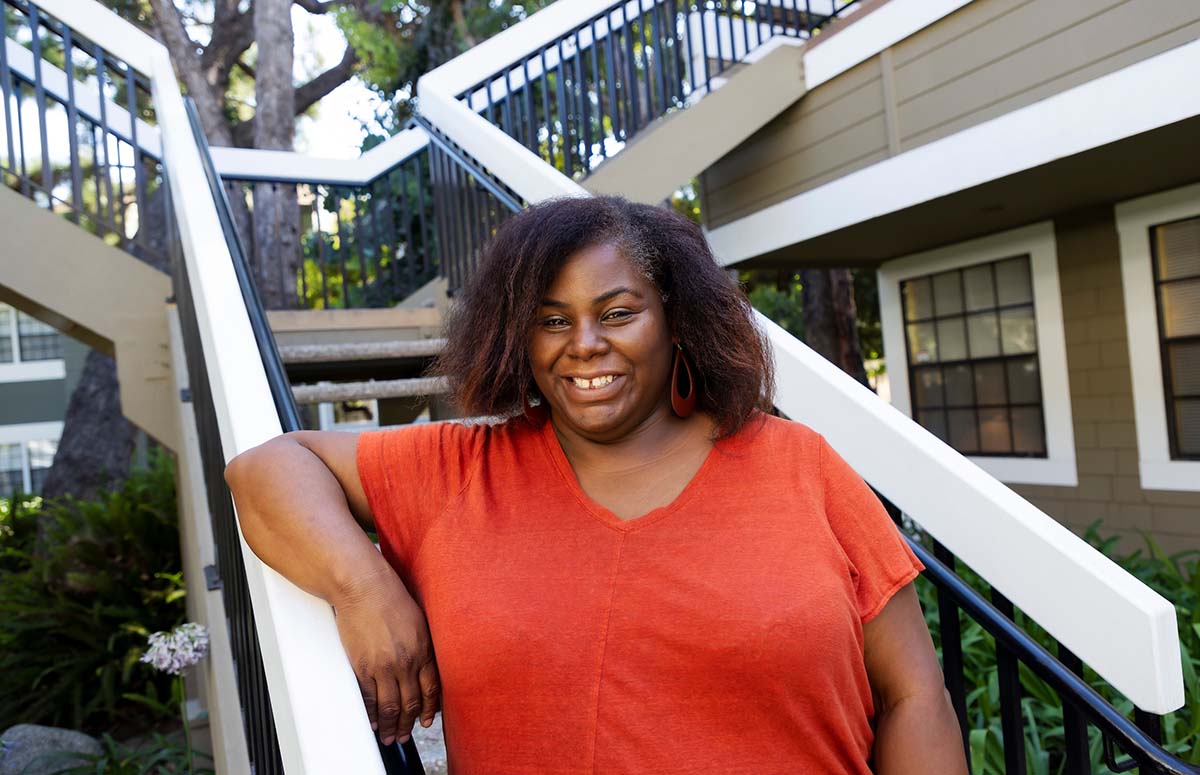The Gatekeepers
The Great White Wall: Is Newport Beach Dodging California’s Fair Housing Law?
The city’s housing plan may not create the integrated and balanced communities that state law requires.

When Tamara Fairbanks, an elementary school music teacher, would enter a classroom in Newport Beach, she knew she was probably the first African American some of her students had ever seen. Newport Beach is 85% white, and its population, along with a handful of neighboring seaside towns, looks more South Dakota than Southern California.
Co-published by LAist
Built along a dazzling 10-mile coastline, Newport was home to Hollywood cowboy John Wayne and basketball great Kobe Bryant. And in the early 2000s, Newport Beach gained even greater cachet as the glamorous backdrop for the teen drama The OC, which featured a troubled working-class kid adjusting to life among the rich and entitled.
Fairbanks taught in the Newport Mesa Unified School District for 20 years before she was elected union president last summer. Now, back in the classroom, she is one of only four Black teachers in the 22,000-student district that serves the cities of Costa Mesa and Newport Beach.
In 10 years, however, the city and its schools could look a lot different. Because pricey California enclaves like Newport Beach, Rancho Palos Verdes, Atherton and Bradbury can be exclusive no longer, according to AB 686, a 2018 fair housing law that takes full effect this year.
Southern California cities and counties must plan for 1.5 million new housing units, from low to middle income, to ease the state’s vast shortage. And all jurisdictions — not just posh coastal hideaways — must replace “segregated living patterns with truly integrated and balanced” ones. All of this may mean the end of Newport Beach as those who live there know it.
Under California’s new housing law, the price of admission to its best performing schools, fresh air, quality parks and libraries is no longer a $2 million home. Instead, so-called high-opportunity cities like Newport and neighboring Laguna Beach and Huntington Beach, rich with such amenities, must open their doors to those who are now priced out.
Capital & Main’s reporting shows Newport Beach has relegated most of its planned new housing to industrial and commercial parts of town, calling into question whether the city’s plan actually creates the integrated and balanced communities the state law requires.

Tamara Fairbanks. Photo by Ted Soqui.
San Diego County cities, whose deadline to submit housing plans was April 15, 2021, have already had problems sharing the wealth. State housing officials sent all but one of the cities and San Diego County itself back to the drawing board — some more than once — to redo the fair housing sections of their plans. To date, just two of 19 San Diego County jurisdictions have gained state approval of their housing plans.
All Southern California cities face an October deadline to show how they’ll meet their state-mandated goals for housing at extremely low to middle income levels — known as the regional housing needs allocation, or RHNA. It’s a difficult dance because cities don’t generally build housing, and neither state nor local government can tell private developers what to do with their own land. So, the state has devised a complex workaround to try to ensure that cities plan for sufficient affordable housing. State housing officials use density as a stand-in for affordability, theorizing that denser housing will result in lower rents. Thus, under state rules, cities must zone sufficient land at densities of between 10 and 30 dwelling units per acre to show they can accommodate their lower cost housing goals.
* * *
Another feature of California’s housing law is that cities and counties can’t put up barriers to development, charge excessive fees, or take too long to allow a project to go forward.
In Newport Beach, emails obtained by Capital & Main through a public records request show local officials and civic activists gritting their teeth and venting in private that the state goals are impossible to reach, even as they work to draft a plan that will pass the state’s test. Larry Tucker, a former real estate attorney who chairs the city’s housing element update advisory committee, wrote in a February 2021 email to City Councilman Will O’Neill, “And, no I haven’t yet heard of a remotely realistic explanation as to how the state expects the city to plan for 49% of our RHNA to be planned for lower-income occupants. To quote Dana Carvey imitating George HW Bush, ‘Ain’t gonna happen.’”
California cities have been submitting these housing elements, part of their general plans, for a half-century. But in recent years state lawmakers began to tighten the law’s requirement and grant the state’s Department of Housing and Community Development the enforcement tools needed to make a dent in the state’s housing crisis — and attack its racial and economic divides.
In California, cities whose housing plans don’t pass muster face escalating sanctions, from the loss of state housing funds to action by the attorney general.
“It has the potential to be transformative,” says Sam Tepperman-Gelfant, a managing attorney at the Sacramento-based nonprofit law firm Public Advocates, because of new state fair housing law AB 686 and its requirement “that every local community look deeply at housing disparities for people of color, immigrants, people with disabilities and other protected classes.”
California leads the country in fair housing efforts, but several states — motivated by their own housing crises — are moving in similar directions. In New York, legislators have also approved a bill that requires state agencies and cities that receive state funding to reverse patterns of segregation. It is currently awaiting the governor’s signature. Virginia has approved a new law that makes it illegal to discriminate in permitting affordable housing, while new legislation in Maryland strengthens anti-housing discrimination laws.
In California, cities whose plans don’t pass muster face escalating sanctions, from the loss of state housing funds to action by the attorney general including the suspension of a city’s power to make its own land-use decisions.
In the past, wealthy cities got a break when it came to meeting low income housing goals. In 2014, for example, the Southern California Association of Governments assigned Newport Beach a goal of planning for just two low income housing units over eight years, while Lake Forest, a less exclusive Orange County city of similar size, had to make way for nearly 1,100. Not anymore. This year, Newport Beach’s allocation exceeds Lake Forest’s by about 1,000 homes.
* * *
“Panic” was Newport Mayor Brad Avery’s reaction when he heard the city would have to plan for 4,845 new housing units by 2029, with more than half affordable to low and moderate income people.
Avery is a lifelong sailor by avocation who retired last year as director of the marine program at Orange Coast College. He bought a home in Newport for $280,000 in the 1980s after a lifetime of weekends at the harbor. His house is now worth $2 million “through no fault of my own.” He’s tall with white hair, the sunburnt face of a seafarer and an air of ease, even as he tries to strike a balance between following state housing law and staying out of hot water with his constituents.
“To go from two to 4,845, it’s just a big jump,” he declares. “I was panicked for Seimone.”
Seimone Jurjis is the city’s planning director.
The sudden population rise would strain public services. “Where’s our fire, police, schools?” Jurjis says, noting that ideally a city would plan a community taking all of those factors into account at the same time instead of rushing to plan for housing in a vacuum, and adding infrastructure, retail and other amenities later.
Most cities with lots of exclusively single-family housing like Newport Beach will have to rezone so that they can accommodate more affordable multifamily dwellings.
Newport Beach will comply with the law, Avery says, “right down the line,” but it may prove difficult to satisfy both residents and state regulators.
City officials are bracing for tough state oversight. “They’re playing hardball,” Jurjis told the city council in February as he briefed them on the city’s efforts to draft its housing plan.
Most cities with lots of exclusively single-family housing like Newport Beach will have to rezone so that they can accommodate more affordable multifamily dwellings.
But Jurjis reassured the council that none of the proposed housing sites are near established neighborhoods, so their single family status remains intact.
Residents have registered concerns that the big jump in units will snarl traffic and add to crowding. And they don’t like the state telling the city what to do when it comes to city planning.
Later that month, the Newport Council unanimously passed a resolution protesting the state’s interference “with cities’ ability to control their own destiny through the use of the zoning authority that’s been granted them.” Some 40 other California cities have done the same. In June, the Orange County Council of Governments sued the state, arguing it inflated the region’s housing needs.
Civic activist Nancy Scarbrough commented at a housing advisory committee meeting in March that she could not “imagine our community” with the kind of low income, high density housing that she’s seen in nearby Santa Ana, a predominantly Latino, working class city some 10 miles north of Newport. “The city’s going to look and feel different,” Scarbrough told Capital & Main, adding that streets and restaurants are already crowded.
“This is a mandate by a governor who is subject to recall,” Scarbrough said at the meeting.
* * *
This spring, Avery and Jurjis, with a copy of the city’s new draft plan under his arm, settled in at a picnic table in the shadow of a five-story apartment building near John Wayne Airport, on the north end of the city. Ninety-two of the building’s 600 units are affordable to low income people per an agreement between the city and the developer. The apartment is an example of the kind of housing the city hopes to attract, but it’s so close to the airport that planes rumbling overhead drown out conversation.
Newport plans to put more than 22% of its housing in this area — currently zoned as light industrial and home to office buildings, a semiconductor manufacturer, sailmakers and other marine industries.
The rest of the city’s proposed sites — at the edge of the Coyote Canyon landfill, the Fashion Island Mall and a few others — are equally far removed from most Newport homeowners. The city doesn’t plan to change its single-family zoning to make way for apartments.
“We’re a long way from panic now,” Avery says, now that hundreds of potential new housing sites have been found.
But Avery could be in for a new set of headaches because in addition to the isolation of the proposed housing, most of it is concentrated in the city’s least desirable areas. The only exception is some 1,000 additional accessory dwelling units that residents are expected to build on their properties.
“I do believe more affordable housing would better Newport and bring in more middle income families. I hope we will have more of a melting pot — I think it’s needed.”
~ Tamara Fairbanks, teacher
“No way” would the Newport Beach plan pass legal muster, says Sonja Trauss, the director of San Francisco-based YIMBY (Yes In My Backyard) Law. The group, whose slogan is “sue the suburbs,” is monitoring Newport and other cities for housing law violations.
At a housing plan workshop in March, Trauss pointed out that Newport Beach’s housing plan fails to include a way to integrate parts of the city that are more than 90% white.”
“That [segregation] doesn’t happen just by coincidence,” Trauss says. “You’re required to replace segregated living patterns with integrated living patterns — there has to be some plan or program on how to achieve that.”
Cesar Covarrubias of Orange County housing watchdog the Kennedy Commission was also observing the online proceedings, as was Richard Walker, senior attorney at the Orange County-based Public Law Center.
These groups could ultimately file suit against noncompliant cities.
* * *
“A great outcome would be if half the cities fall out of compliance,” says Chris Elmendorf, a University of California, Davis, law professor who writes extensively on land use issues. “Because that would communicate it’s time to get real.” That is, it might force the state to take housing element law seriously.
“I think it’s not clear how this is going to play out.”
If state regulators do crack down on California cities, it will be up to the courts to decide how much leeway to give them, Elmendorf says.
Mayor Brad Avery, who joined in approving the city council resolution protesting the loss of local land-use control, nonetheless told Capital & Main that he believes residents will adapt to new neighbors. Their “concerns about the kinds of people who will live in these apartments” aren’t justified. “These are people we know,” he says, gardeners and housekeepers and even family members like Avery’s own 23-year old stepson who goes to community college, works in a coffee shop and needs housing.
They could also be teachers, like Tamara Fairbanks, most of whom are shut out of the rental and real estate markets in the city they serve, and make grueling commutes to get to their jobs.
“I do believe more affordable housing would better Newport and bring in more middle income families,” she says. “I think our students benefit greatly from diversity economically and ethnically. The more diverse your pool, the more experience people bring to the table, and the more students benefit. I hope we will have more of a melting pot — I think it’s needed.”
Sonja Trauss says her group will continue to keep a close eye on Newport Beach, because strong housing laws on the books alone don’t ensure that cities will share the wealth with other Californians. Enforcement, she says, is key to making California’s big housing experiment work.
“All of our laws are not laws of physics. It’s up to good people to show up and demand they be followed.”
Copyright 2021 Capital & Main

-

 Latest NewsJune 17, 2025
Latest NewsJune 17, 2025A Coal Miner’s Daughter Takes on DOGE to Protect Miners’ Health
-

 Beyond the BorderJune 10, 2025
Beyond the BorderJune 10, 2025Detained Man Says ICE Isn’t Treating His Colon Cancer
-

 Column - State of InequalityJune 5, 2025
Column - State of InequalityJune 5, 2025Budget Cuts Threaten In-Home Assistance Workers and Medi-Cal Recipients
-

 Column - State of InequalityJune 12, 2025
Column - State of InequalityJune 12, 2025‘Patients Will Suffer. Patients Will Die.’ Why California’s Rural Hospitals Are Flatlining.
-

 Column - California UncoveredJune 18, 2025
Column - California UncoveredJune 18, 2025Can Gov. Gavin Newsom Make Californians Healthier?
-

 Featured VideoJune 10, 2025
Featured VideoJune 10, 2025Police Violently Crack Down on L.A. Protests
-

 Latest NewsJune 4, 2025
Latest NewsJune 4, 2025Grace Under Fire: Transgender Student Athlete AB Hernandez’s Winning Weekend
-

 Striking BackJune 3, 2025
Striking BackJune 3, 2025In Georgia, Trump Is Upending Successful Pro-Worker Reforms

